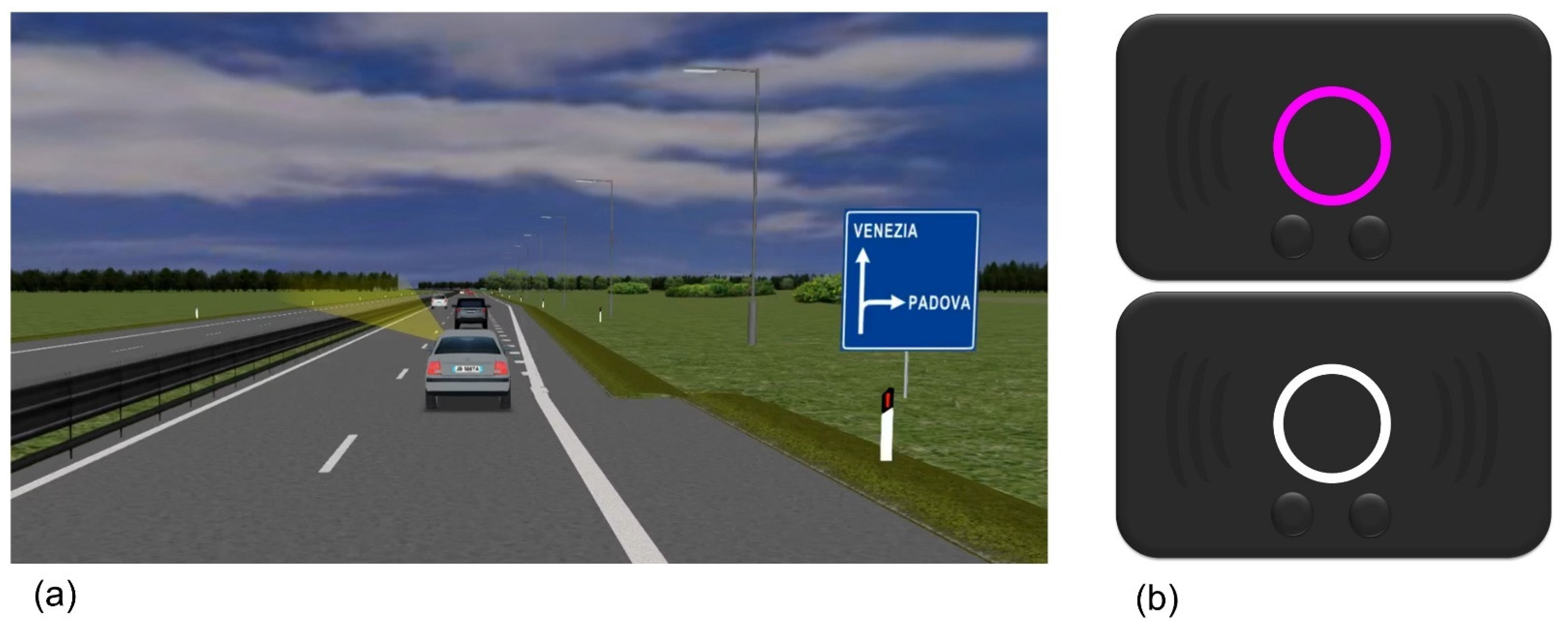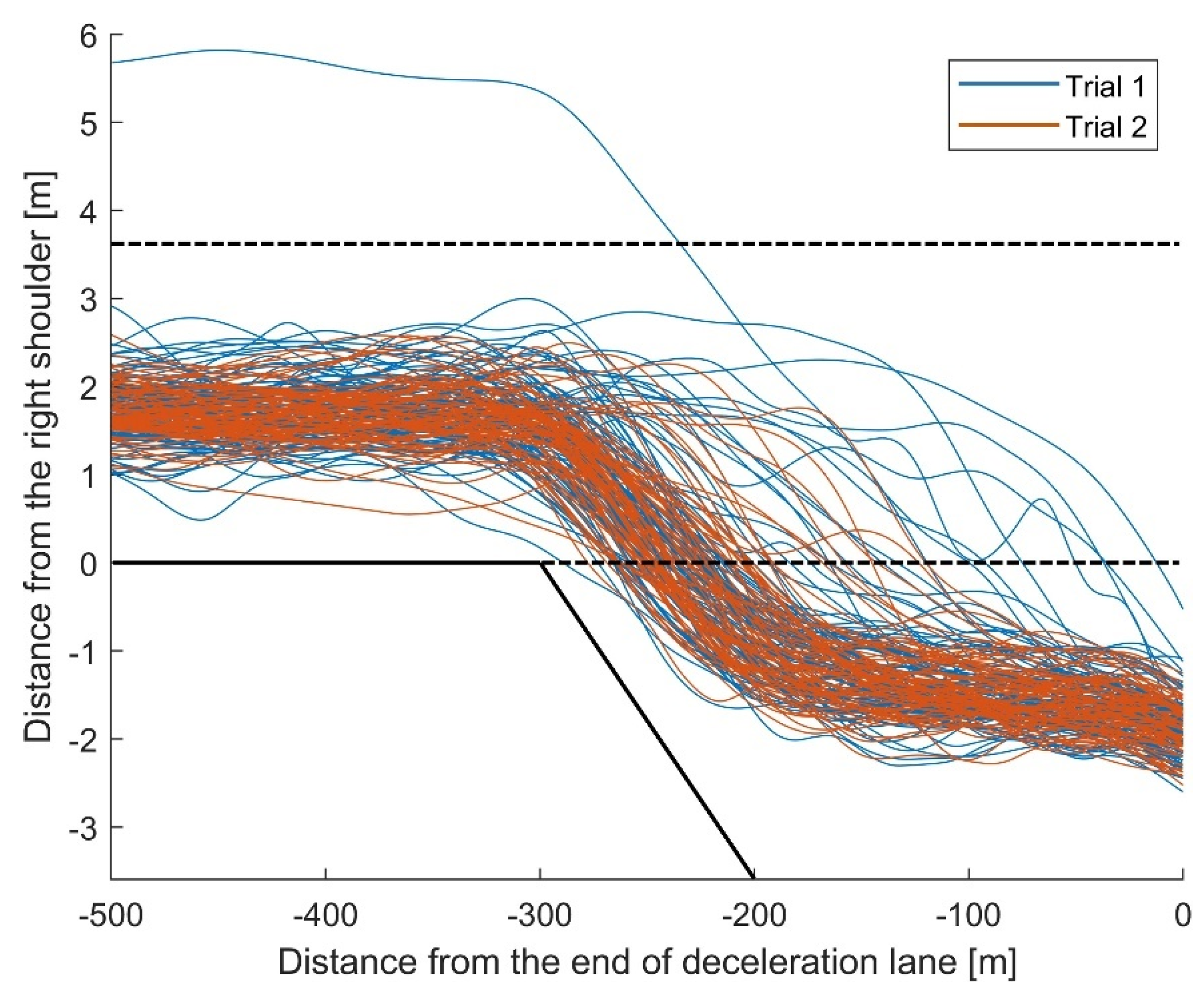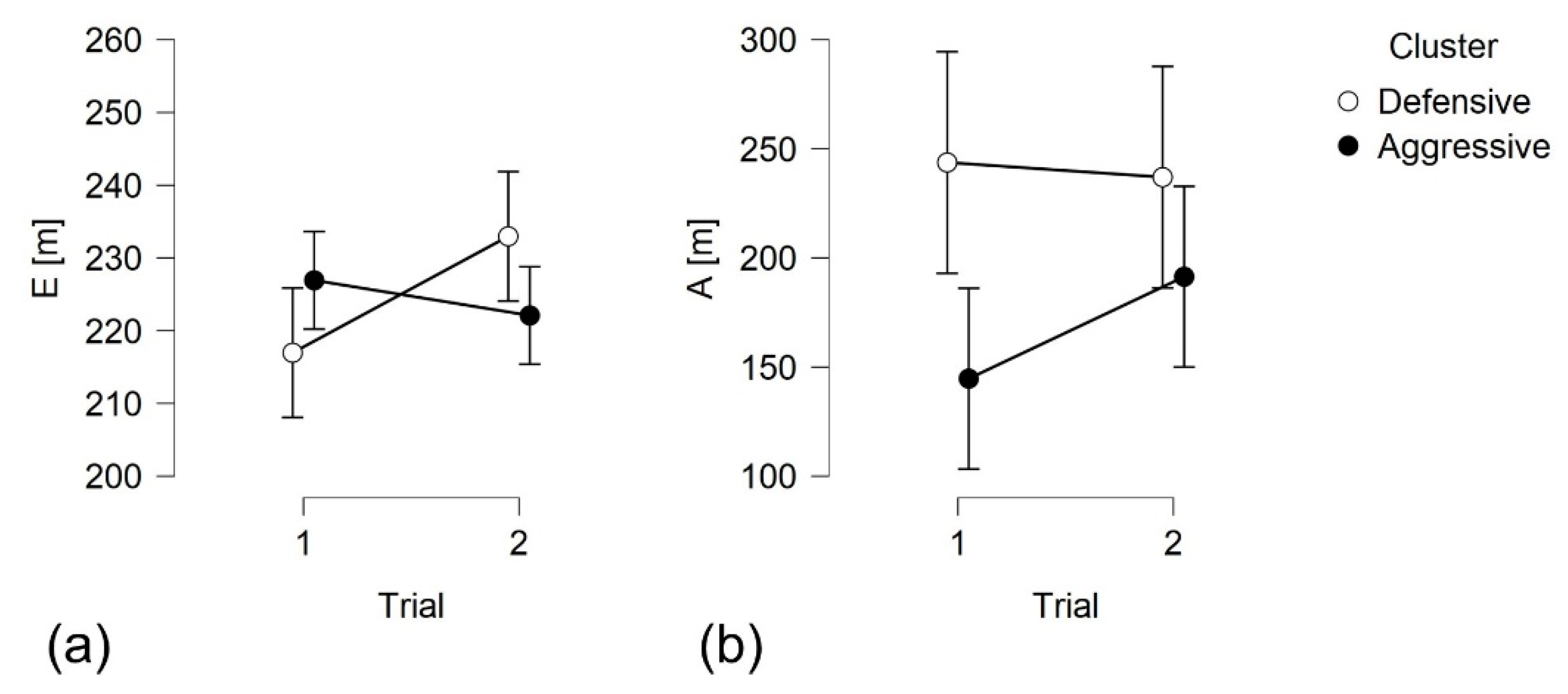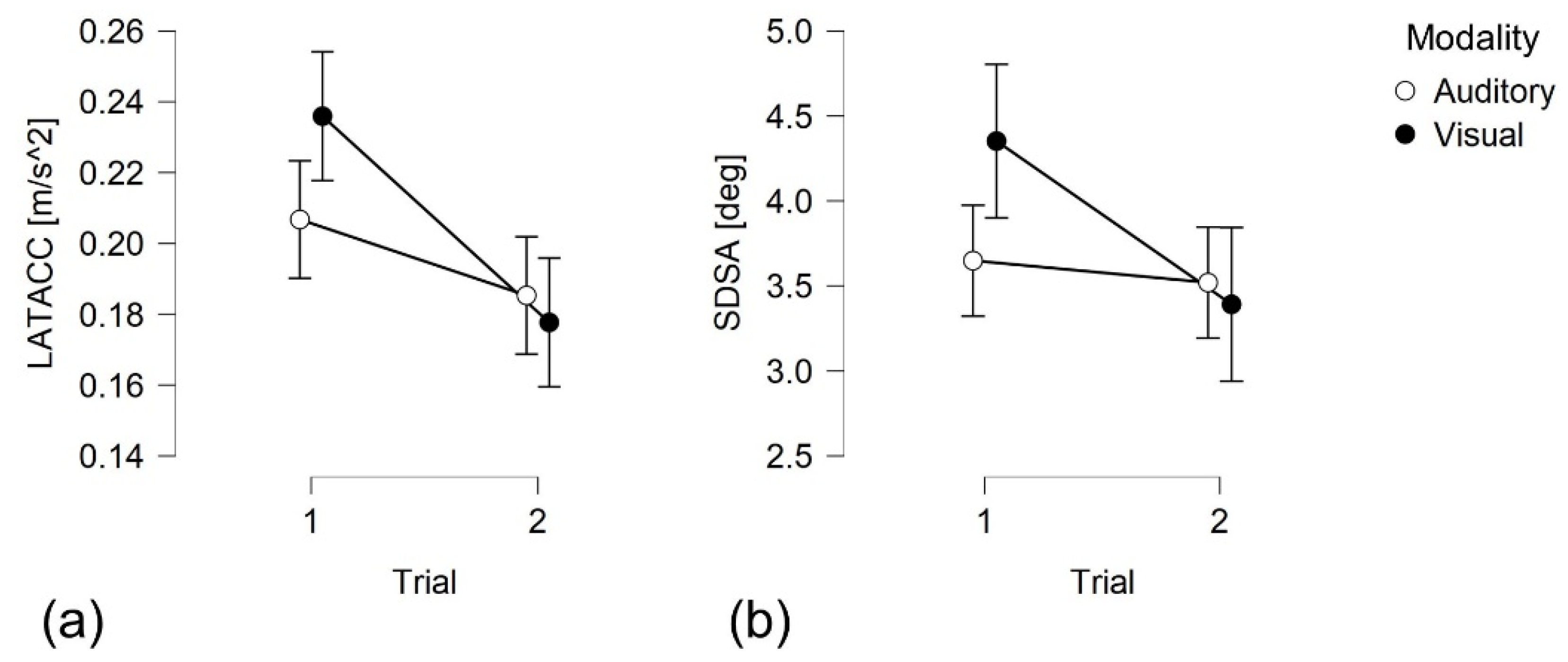Highway Deceleration Lane Safety: Effects of Real-Time Coaching Programs on Driving Behavior
Abstract
:1. Introduction
1.1. Safety of Highway Deleceration Lanes
1.2. “Pay-How-You-Drive” Insurance Schemes
1.3. Aim of the Study
2. Methodology
2.1. Driving Simulator Experiment
2.1.1. Participants
2.1.2. Apparatus
2.1.3. Experimental Design
2.1.4. Real-Time Coaching Program
- Harsh event: a timeframe longer than 1 s exceeding a deceleration threshold of −0.4 g or an acceleration threshold of 0.3 g.
- Smooth event: a timeframe longer than 1 s exceeding a minimum deceleration/acceleration threshold (±0.075 g) without exceeding the deceleration threshold of −0.4g or the acceleration threshold of 0.3 g.
2.1.5. Highway Scenario
2.2. Variables Analyzed
- V_MEAN [km/h]. The average speed on the highway, calculated from D = 2300 m to D = 1300 m, therefore, before the first traffic sign indicating the highway exit.
- ΔV1 [km/h]. Speed change at the beginning of the deceleration lane, calculated as the difference between the speed at D = 300 m and V_MEAN.
- ΔV2 [km/h]. Speed change when entering the deceleration lane, calculated as the difference between the speed recorded when the vehicle’s center of gravity (COG) entered the deceleration lane and V_MEAN.
- ΔV3 [km/h]. Speed change at the end of the deceleration lane, calculated as the difference between the speed at D = 0 m and V_MEAN.
- DEC_MEAN [m/s2]. Average deceleration between D = 500 m and D = 0 m.
- DEC_MAX [m/s2]. Maximum deceleration between D = 500 m and D = 0 m.
- E [m], “exit point”, defined as the point in the space between D = 300 m and D = 0 m where the vehicle’s COG enters the deceleration lane.
- A [m], “start-of-deceleration point”, defined as the point in the space between D = 500 m and D = 0 m where the driver first fully raises the foot from the gas pedal (Note that, in principle, A is different from the point where the vehicle actually starts decreasing its speed; moreover, drivers can decelerate even without fully removing the foot from the gas pedal. A was defined in such way to avoid ambiguity in the definition of the deceleration phase, and to be consistent with previous literature [8]).
- LATACC [m/s2]. Average lateral acceleration between D = 300 m and D = 0 m.
- SDSA [degrees]. Standard deviation of steering angle between D = 300 m and D = 0 m.
2.3. Statistical Anlyses
3. Results
3.1. Descriptive Analysis
3.2. Cluster Analysis: Identifying Driving Styles
3.3. Mixed ANOVA: Evaluating the Effect of the Real-Time Coaching Program
- Cluster—aggressive (N = 38) vs. defensive (N = 36)
- Feedback valence—negative (N = 35) vs. positive (N = 39)
- Feedback modality—visual (N = 41) vs. auditory (N = 33)
3.3.1. Speed Variables
3.3.2. Deceleration Variables
3.3.3. Trajectory Variables
3.3.4. Lateral Control Variables
4. Discussion
4.1. Effect of Real-Time Coaching Program on Drivers’ Behavior (Factor Trial)
4.2. Effect of Driving Style on Program Effectiveness (Factor Cluster)
4.3. Effect of Feedback Modality and Variance on Program Effectiveness
5. Conclusions
Author Contributions
Funding
Institutional Review Board Statement
Informed Consent Statement
Data Availability Statement
Acknowledgments
Conflicts of Interest
References
- Torbic, D.J.; Hutton, J.M.; Bokenkroger, C.D.; Harwood, D.W.; Gilmore, D.K.; Knoshaug, M.M.; Ronchetto, J.J.; Brewer, M.A.; Fitzpatrick, K.; Chrysler, S.T.; et al. NCHRP Report 730: Design Guidance for Freeway Mainline Ramp Terminals; National Cooperative Highway Research Program, Transportation Research Board: Washington, DC, USA, 2012; ISBN 9780309258548. [Google Scholar]
- Lundy, R.A. The effect of ramp type and geometry on accidents. Highw. Res. Rec. 1967, 163, 80–119. [Google Scholar]
- McCartt, A.T.; Northrup, V.S.; Retting, R.A. Types and characteristics of ramp-related motor vehicle crashes on urban interstate roadways in Northern Virginia. J. Saf. Res. 2004, 35, 107–114. [Google Scholar] [CrossRef]
- Lord, D.; Bonneson, J.A. Calibration of predictive models for estimating safety of ramp design configurations. Transp. Res. Rec. 2005, 1908, 88–95. [Google Scholar] [CrossRef]
- Bared, J.; Giering, G.L.; Warren, D.L. Safety evaluation of acceleration and deceleration lane lengths. ITE J. 1999, 69, 50–54. [Google Scholar]
- Chen, H.; Zhou, H.; Lin, P.-S. Freeway deceleration lane lengths effects on traffic safety and operation. Saf. Sci. 2014, 64, 39–49. [Google Scholar] [CrossRef]
- Papadimitriou, E.; Theofilatos, A. Meta-analysis of crash-risk factors in freeway entrance and exit areas. J. Transp. Eng. Part A Syst. 2017, 143, 04017050. [Google Scholar] [CrossRef]
- Calvi, A.; Benedetto, A.; De Blasiis, M. A driving simulator study of driver performance on deceleration lanes. Accid. Anal. Prev. 2012, 45, 195–203. [Google Scholar] [CrossRef]
- Calvi, A.; Bella, F.; D’Amico, F. Diverging driver performance along deceleration lanes: Driving simulator study. Transp. Res. Rec. J. Transp. Res. Board 2015, 2518, 95–103. [Google Scholar] [CrossRef]
- Calvi, A.; Bella, F.; D’Amico, F. Evaluating the effects of the number of exit lanes on the diverging driver performance. J. Transp. Saf. Secur. 2016, 10, 105–123. [Google Scholar] [CrossRef]
- Calvi, A.; D’Amico, F.; Ferrante, C.; Bianchini Ciampoli, L. A driving simulator validation study for evaluating the driving performance on deceleration and acceleration lanes. Adv. Transp. Stud. 2020, 50, 67–80. [Google Scholar] [CrossRef]
- Lyu, N.; Cao, Y.; Wu, C.; Xu, J.; Xie, L. The effect of gender, occupation and experience on behavior while driving on a freeway deceleration lane based on field operational test data. Accid. Anal. Prev. 2018, 121, 82–93. [Google Scholar] [CrossRef]
- Tselentis, D.I.; Yannis, G.; Vlahogianni, E.I. Innovative motor insurance schemes: A review of current practices and emerging challenges. Accid. Anal. Prev. 2017, 98, 139–148. [Google Scholar] [CrossRef] [PubMed]
- Carfora, M.F.; Martinelli, F.; Mercaldo, F.; Nardone, V.; Orlando, A.; Santone, A.; Vaglini, G. A “Pay-How-You-Drive” car insurance approach through cluster analysis. Soft Comput. 2019, 23, 2863–2875. [Google Scholar] [CrossRef]
- Mendels, O.; Bertental, G.; Kamara, T. Unsupervised Driver Safety Estimation at Scale, a Collaboration with Pointer Telocation. Available online: https://devblogs.microsoft.com/cse/2018/07/30/unsupervised-driver-safety-estimation-at-scale/ (accessed on 13 August 2021).
- Handel, P.; Skog, I.; Wahlstrom, J.; Bonawiede, F.; Welch, R.; Ohlsson, J.; Ohlsson, M. Insurance telematics: Opportunities and challenges with the smartphone solution. IEEE Intell. Transp. Syst. Mag. 2014, 6, 57–70. [Google Scholar] [CrossRef]
- Boquete, L.; Rodríguez-Ascariz, J.M.; Barea, R.; Cantos, J.; Miguel-Jiménez, J.M.; Ortega, S. Data Acquisition, analysis and transmission platform for a pay-as-you-drive system. Sensors 2010, 10, 5395–5408. [Google Scholar] [CrossRef]
- Hu, X.; Zhu, X.; Ma, Y.; Chiu, Y.; Tang, Q. Advancing usage-based insurance—A contextual driving risk modelling and analysis approach. IET Intell. Transp. Syst. 2019, 13, 453–460. [Google Scholar] [CrossRef]
- Shi, X.; Wong, Y.D.; Li, M.Z.-F.; Palanisamy, C.; Chai, C. A feature learning approach based on XGBoost for driving assessment and risk prediction. Accid. Anal. Prev. 2019, 129, 170–179. [Google Scholar] [CrossRef] [PubMed]
- Soleymanian, M.; Weinberg, C.B.; Zhu, T. Sensor data and behavioral tracking: Does usage-based auto insurance benefit drivers? Mark. Sci. 2019, 38, 21–43. [Google Scholar] [CrossRef]
- Ryder, B.; Dahlinger, A.; Gahr, B.; Zundritsch, P.; Wortmann, F.; Fleisch, E. Spatial prediction of traffic accidents with critical driving events—Insights from a nationwide field study. Transp. Res. Part A Policy Pract. 2019, 124, 611–626. [Google Scholar] [CrossRef]
- Winlaw, M.; Steiner, S.H.; Mackay, R.J.; Hilal, A.R. Using telematics data to find risky driver behaviour. Accid. Anal. Prev. 2019, 131, 131–136. [Google Scholar] [CrossRef] [PubMed]
- Toledo, G.; Shiftan, Y. Can feedback from in-vehicle data recorders improve driver behavior and reduce fuel consumption? Transp. Res. Part A Policy Pract. 2016, 94, 194–204. [Google Scholar] [CrossRef]
- Toledo, T.; Musicant, O.; Lotan, T. In-vehicle data recorders for monitoring and feedback on drivers’ behavior. Transp. Res. Part C Emerg. Technol. 2008, 16, 320–331. [Google Scholar] [CrossRef]
- Reagan, I.J.; Bliss, J.P.; Van Houten, R.; Hilton, B.W. The effects of external motivation and real-time automated feedback on speeding behavior in a naturalistic setting. Hum. Factors J. Hum. Factors Ergon. Soc. 2013, 55, 218–230. [Google Scholar] [CrossRef] [Green Version]
- Biondi, F.N.; Rossi, R.; Gastaldi, M.; Orsini, F.; Mulatti, C. Precision teaching to improve drivers’ lane maintenance. J. Saf. Res. 2020, 72, 225–229. [Google Scholar] [CrossRef] [PubMed]
- Pappalardo, G.; Cafiso, S.; Di Graziano, A.; Severino, A. decision tree method to analyze the performance of lane support systems. Sustainability 2021, 13, 846. [Google Scholar] [CrossRef]
- Hibberd, D.; Jamson, A.; Jamson, S. The design of an in-vehicle assistance system to support eco-driving. Transp. Res. Part C Emerg. Technol. 2015, 58, 732–748. [Google Scholar] [CrossRef]
- Huang, Y.; Ng, E.C.; Zhou, J.L.; Surawski, N.; Chan, E.F.; Hong, G. Eco-driving technology for sustainable road transport: A review. Renew. Sustain. Energy Rev. 2018, 93, 596–609. [Google Scholar] [CrossRef]
- Dijksterhuis, C.; Lewis-Evans, B.; Jelijs, L.H.; Tucha, O.; de Waard, D.; Brookhuis, K. In-car usage-based insurance feedback strategies. A comparative driving simulator study. Ergonomics 2016, 59, 1158–1170. [Google Scholar] [CrossRef] [PubMed] [Green Version]
- Dijksterhuis, C.; Lewis-Evans, B.; Jelijs, B.; de Waard, D.; Brookhuis, K.; Tucha, O. The impact of immediate or delayed feedback on driving behaviour in a simulated Pay-As-You-Drive system. Accid. Anal. Prev. 2015, 75, 93–104. [Google Scholar] [CrossRef] [PubMed]
- Rossi, R.; Tagliabue, M.; Gastaldi, M.; De Cet, G.; Freuli, F.; Orsini, F.; Di Stasi, L.L.; Vidotto, G. Reducing elevated gravitational-force events through visual feedback: A simulator study. Transp. Res. Procedia 2021, 52, 115–122. [Google Scholar] [CrossRef]
- Rossi, R.; Orsini, F.; Tagliabue, M.; Di Stasi, L.L.; De Cet, G.; Gastaldi, M. Evaluating the impact of real-time coaching programs on drivers overtaking cyclists. Transp. Res. Part F Traffic Psychol. Behav. 2021, 78, 74–90. [Google Scholar] [CrossRef]
- Simons-Morton, B.G.; Zhang, Z.; Jackson, J.C.; Albert, P.S. Do elevated gravitational-force events while driving predict crashes and near crashes? Am. J. Epidemiol. 2012, 175, 1075–1079. [Google Scholar] [CrossRef] [PubMed] [Green Version]
- Tselentis, D.; Theofilatos, A.; Yannis, G.; Konstantinopoulos, M. Public opinion on usage-based motor insurance schemes: A stated preference approach. Travel Behav. Soc. 2018, 11, 111–118. [Google Scholar] [CrossRef]
- Bolderdijk, J.; Knockaert, J.; Steg, E.; Verhoef, E. Effects of Pay-As-You-Drive vehicle insurance on young drivers’ speed choice: Results of a dutch field experiment. Accid. Anal. Prev. 2011, 43, 1181–1186. [Google Scholar] [CrossRef] [Green Version]
- World Medical Association. World Medical Association declaration of helsinki: Ethical principles for medical research involving human subjects. JAMA 2013, 310, 2191–2194. [Google Scholar] [CrossRef] [PubMed] [Green Version]
- Rossi, R.; Gastaldi, M.; Meneguzzer, C. Headway distribution effect on gap-acceptance behavior at roundabouts: Driving simulator experiments in a case study. Adv. Transp. Stud. 2018, 46, 97–110. [Google Scholar] [CrossRef]
- Rossi, R.; Meneguzzer, C.; Orsini, F.; Gastaldi, M. Gap-acceptance behavior at roundabouts: Validation of a driving simulator environment using field observations. Transp. Res. Procedia 2020, 47, 27–34. [Google Scholar] [CrossRef]
- Orsini, F.; Gecchele, G.; Gastaldi, M.; Rossi, R. Collision prediction in roundabouts: A comparative study of extreme value theory approaches. Transp. A Transp. Sci. 2019, 15, 556–572. [Google Scholar] [CrossRef]
- Gastaldi, M.; Orsini, F.; Gecchele, G.; Rossi, R. Safety analysis of unsignalized intersections: A bivariate extreme value approach. Transp. Lett. 2021, 13, 209–218. [Google Scholar] [CrossRef]
- Rossi, R.; Gastaldi, M.; Gecchele, G.; Biondi, F.; Mulatti, C. Traffic-calming measures affecting perceived speed in approaching bends. Transp. Res. Rec. J. Transp. Res. Board 2014, 2434, 35–43. [Google Scholar] [CrossRef]
- Wåhlberg, A.A. Changes in driver celeration behaviour over time: Do drivers learn from collisions? Transp. Res. Part F Traffic Psychol. Behav. 2012, 15, 471–479. [Google Scholar] [CrossRef]
- Bradley, M.M.; Lang, P. Affective Norms for English Words (ANEW): Stimuli, Instruction Manual and Affective Ratings; Technical Report No., C-1; NIMH: Gainesville, FL, USA; The Center for Research in Psychophysiology: Gainesville, FL, USA, January 1999. [Google Scholar]
- Gianfranchi, E.; Tagliabue, M.; Spoto, A.; Vidotto, G. Sensation Seeking, non-contextual decision making, and driving abilities as measured through a moped simulator. Front. Psychol. 2017, 8, 2126. [Google Scholar] [CrossRef] [Green Version]
- Gianfranchi, E.; Tagliabue, M.; Vidotto, G. Personality traits and beliefs about peers’ on-road behaviors as predictors of adolescents’ moped-riding profiles. Front. Psychol. 2018, 9, 2483. [Google Scholar] [CrossRef] [PubMed]
- Gianfranchi, E.; Spoto, A.; Tagliabue, M. Risk profiles in novice road users: Relation between moped riding simulator performance, on-road aberrant behaviors and dangerous driving. Transp. Res. Part F Traffic Psychol. Behav. 2017, 49, 132–144. [Google Scholar] [CrossRef]
- Cohen, J. Statistical Power Analysis for the Behavioral Sciences, 2nd ed.; Lawrence Erlbaum Associates: New York, NY, USA, 1988; ISBN 0805802835. [Google Scholar]
- Team JASP. Computer Software, Version 0.13.1; JASP: Amsterdam, The Netherlands, 2020. [Google Scholar]
- Love, J.; Selker, R.; Marsman, M.; Jamil, T.; Dropmann, D.; Verhagen, J.; Ly, A.; Gronau, Q.F.; Smíra, M.; Epskamp, S.; et al. JASP: Graphical statistical software for common statistical designs. J. Stat. Softw. 2019, 88, 1–17. [Google Scholar] [CrossRef] [Green Version]
- El-Basha, R.H.S.; Hassan, Y.; Sayed, T.A. Modeling freeway diverging behavior on deceleration lanes. Transp. Res. Rec. J. Transp. Res. Board 2007, 2012, 30–37. [Google Scholar] [CrossRef]
- Fukutome, I.; Moskowitz, K. Traffic behavior and off-ramp design. Highw. Res. Rec. 1963, 21, 17–31. [Google Scholar]
- Van Beinum, A.; Farah, H.; Wegman, F.; Hoogendoorn, S. Driving behaviour at motorway ramps and weaving segments based on empirical trajectory data. Transp. Res. Part C Emerg. Technol. 2018, 92, 426–441. [Google Scholar] [CrossRef]
- Adell, E.; Vaárhelyi, A.; Alonso, M.; Plaza, J. Developing human–machine interaction components for a driver assistance system for safe speed and safe distance. IET Intell. Transp. Syst. 2008, 2, 1–14. [Google Scholar] [CrossRef]
- Cabral, J.P.; Remijn, G.B. Auditory icons: Design and physical characteristics. Appl. Ergon. 2019, 78, 224–239. [Google Scholar] [CrossRef]
- Cao, Y.; Mahr, A.; Castronovo, S.; Theune, M.; Stahl, C.; Müller, C.A. Local danger warnings for drivers: The effect of modality and level of assistance on driver reaction. In Proceedings of the International Conference on Intelligent User Interfaces, Hong Kong, China, 7–10 February 2010; pp. 239–248. [Google Scholar]
- Harbeck, E.; Glendon, A.I.; Hine, T.J. Reward versus punishment: Reinforcement sensitivity theory, young novice drivers’ perceived risk, and risky driving. Transp. Res. Part F Traffic Psychol. Behav. 2017, 47, 13–22. [Google Scholar] [CrossRef]
- Svenson, O.; Eriksson, G.; Gonzalez, N. Braking from different speeds: Judgments of collision speed if a car does not stop in time. Accid. Anal. Prev. 2011, 45, 487–492. [Google Scholar] [CrossRef] [PubMed]
- Svenson, O. Biased judgments of the effects of speed change on travel time, fuel consumption and braking: Individual differences in the use of simplifying rules producing the same biases. Transp. Res. Part F Traffic Psychol. Behav. 2021, 78, 398–409. [Google Scholar] [CrossRef]
- Tscharaktschiew, S. The private (unnoticed) welfare cost of highway speeding behavior from time saving misperceptions. Econ. Transp. 2016, 7–8, 24–37. [Google Scholar] [CrossRef]







| Variable | Trial 1 | Trial 2 |
|---|---|---|
| V_MEAN [km/h] | 92.33 (7.89) | 87.59 (8.03) |
| ΔV1 [km/h] | −1.40 (7.88) | −2.59 (7.59) |
| ΔV2 [km/h] | −2.11 (8.01) | −4.84 (8.27) |
| ΔV3 [km/h] | −14.29 (8.55) | −17.01 (9.42) |
| DEC_MEAN [m/s2] | −0.46 (0.22) | −0.41 (0.16) |
| DEC_MAX [m/s2] | −1.05 (0.34) | −0.95 (0.28) |
| E [m] | 222.08 (43.93) | 227.38 (33.33) |
| A [m] | 189.16 (133.67) | 211.64 (124.45) |
| LATACC [m/s2] | 0.22 (0.07) | 0.18 (0.06) |
| SDSA [°] | 4.04 (1.71) | 3.45 (1.25) |
Publisher’s Note: MDPI stays neutral with regard to jurisdictional claims in published maps and institutional affiliations. |
© 2021 by the authors. Licensee MDPI, Basel, Switzerland. This article is an open access article distributed under the terms and conditions of the Creative Commons Attribution (CC BY) license (https://creativecommons.org/licenses/by/4.0/).
Share and Cite
Orsini, F.; Tagliabue, M.; De Cet, G.; Gastaldi, M.; Rossi, R. Highway Deceleration Lane Safety: Effects of Real-Time Coaching Programs on Driving Behavior. Sustainability 2021, 13, 9089. https://doi.org/10.3390/su13169089
Orsini F, Tagliabue M, De Cet G, Gastaldi M, Rossi R. Highway Deceleration Lane Safety: Effects of Real-Time Coaching Programs on Driving Behavior. Sustainability. 2021; 13(16):9089. https://doi.org/10.3390/su13169089
Chicago/Turabian StyleOrsini, Federico, Mariaelena Tagliabue, Giulia De Cet, Massimiliano Gastaldi, and Riccardo Rossi. 2021. "Highway Deceleration Lane Safety: Effects of Real-Time Coaching Programs on Driving Behavior" Sustainability 13, no. 16: 9089. https://doi.org/10.3390/su13169089
APA StyleOrsini, F., Tagliabue, M., De Cet, G., Gastaldi, M., & Rossi, R. (2021). Highway Deceleration Lane Safety: Effects of Real-Time Coaching Programs on Driving Behavior. Sustainability, 13(16), 9089. https://doi.org/10.3390/su13169089






